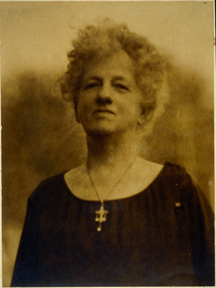Arnold Genthe
Arnold Genthe photographed New Orleans in the 1920s.

Courtesy of The Historic New Orleans Collection
Grace King. Genthe, Arnold (Photographer)
Though perhaps best known for his images of San Francisco’s Chinatown and his portraits of celebrities, German photographer Arnold Genthe also photographed New Orleans in the 1920s. Much of his work, including his photographs of New Orleans, reflected the influence of pictorialism, a photographic style, popular in the late nineteenth and early twentieth centuries, that sought to emulate paintings. Using soft focus, special filters, lens coatings, and special developing techniques, pictorialists tended to romanticize or idealize their subject. Reflective of this style, Genthe’s 1926 Impressions of Old New Orleans creates nostalgic, idealized images of the city’s French Quarter and Garden District.
Born January 8, 1869, in Germany, Genthe was the son of Hermann Genthe, professor of Latin and Greek, and Louise Zober. He earned a Ph.D. in philology at the University of Jena before briefly attending the Sorbonne in Paris. In 1895, he immigrated to San Francisco, where he worked as a private tutor and taught himself the art of photography. In his spare time, Genthe made periodic forays into Chinatown, photographing its inhabitants with a concealed camera. His images are the only photographic documentation of Chinatown before the San Francisco earthquake. Genthe eventually opened a photographic studio, though it and some of his works were destroyed in the 1906 earthquake. After a trip to Japan, in 1911 Genthe moved to New York City, where he became a successful portrait photographer. Theodore Roosevelt, Woodrow Wilson, Greta Garbo, and Isadora Duncan were among his subjects.
At the time Genthe made the Chinatown pictures, the pictorialist movement flourished in the United States. Worried that the recent invention of the Kodak and other small cameras demeaned photography by making it too accessible, pictorialists aimed to create photographs that were more painterly and artistic. They employed soft focus, textured papers, and emulsions that could be manipulated in the printing process to obscure details and deepen shadows to distinguish their work from that of the casual snap-shooter. Genthe’s Chinatown pictures reveal his romantic pictorialist sensibilities, as did much of his portrait work.
Though not all Genthe’s work is pictorialist, his photographs of New Orleans reflected the style’s influence. Making two trips to New Orleans, Genthe intended to document the city’s Old World charm before modern life changed it forever. He quickly discovered, however, that he was already too late. While evidence of modernism was everywhere, even in the historic French Quarter, Genthe did not let this deter him from making a picturesque portrayal of the city. Using the same soft-focus, pictorial style he had employed in San Francisco, Genthe sought out the old and quaint in New Orleans. When modern elements appeared in his scenes, he simply erased them in the darkroom. A close inspection of many of Genthe’s New Orleans photographs, for example, reveals slight shadows of signs, electric lines, and streetcar tracks that interfered with his romantic preconception of the city.
Remembered as important portrait and historical photographer, Genthe died in August 9, 1942, in Milford, Connecticut. The Library of Congress has the largest collection of his prints and negatives. Though often overlooked, his images of New Orleans did much to establish New Orleans as a “city that time forgot.”